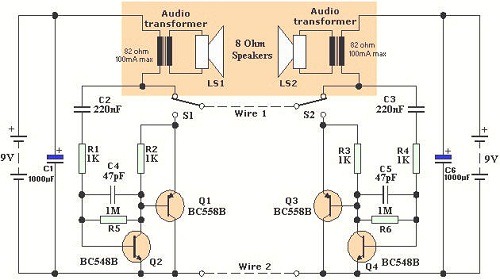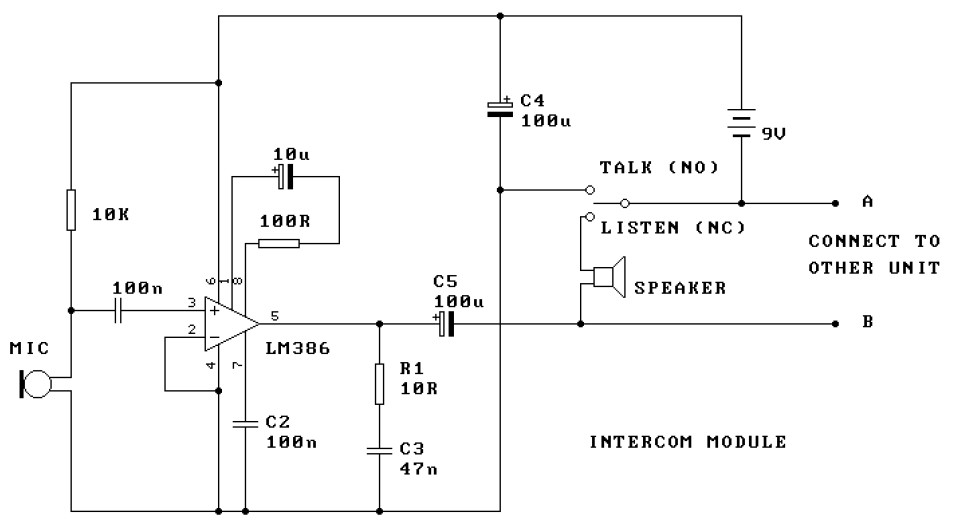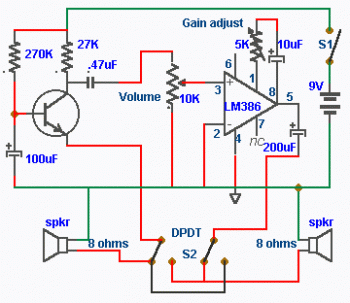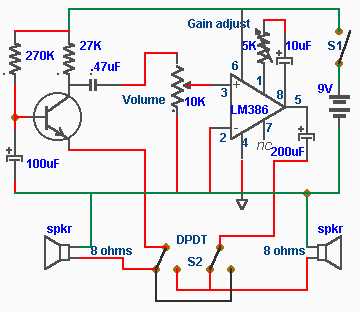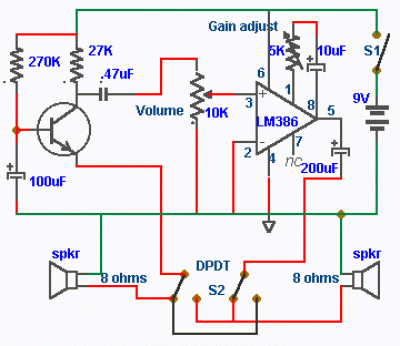
Intercom
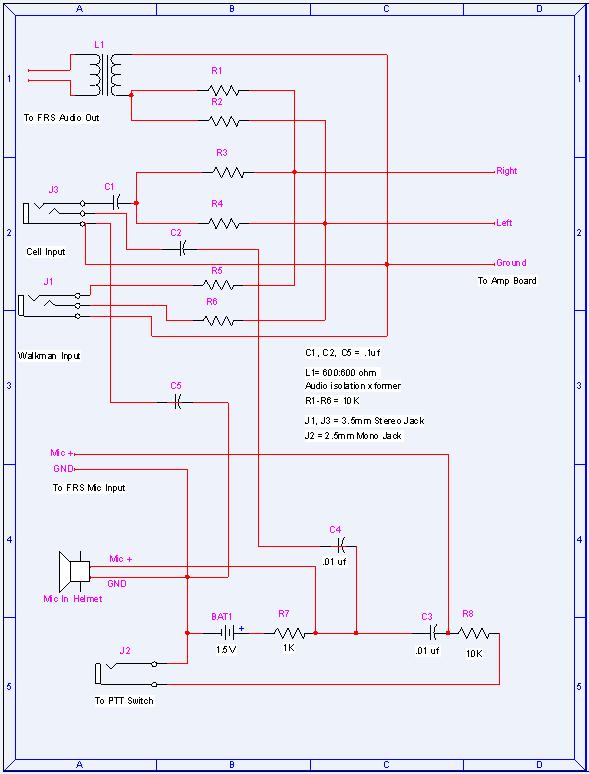
This intercom box accepts input from any 2-way radio (FRS, GMRS, etc.), cell phone, and a stereo audio source, amplifying them for listening through a headset in a helmet. The headset is a modified Chatterbox stereo headset, with the standard Chatterbox microphone replaced by a noise-cancelling microphone equipped with a high-density windsock. This setup aims to provide effective wind noise rejection and a convenient mounting solution for the microphone in a full-face helmet. The audio isolation transformer (L1) eliminates echo caused by the FRS radio not sharing a common ground for audio and microphone signals. Since the cell phone shares a ground, the transformer is not necessary. For those wishing to power this unit and other devices using bike power, Bill Bowden's Hobby Circuits, particularly the Variable Voltage Regulator, can be used to convert bike power into a clean voltage source for the FRS, CD player, amplifier, etc. The Chatterbox headset microphone should be cut off and replaced with the WM55 microphone, which is then inserted into the windsock and secured with a zip tie. The microphone can be attached to the helmet chin bar using Velcro, while the headphone speakers should be mounted and all wires neatly tucked away, ensuring that the plug remains accessible yet out of the way. The components collected should be connected according to the provided diagram. The output of the amplifier and input from the microphone connect to the Chatterbox headset via a 6-pin mini-DIN connector. Although not specified, a 3.5mm stereo jack was chosen for the "To FRS Audio Out" to accommodate radios with a shared ground headset plug, similar to a cell phone. It may be necessary to use two mono jacks, one for FRS audio and another for the FRS microphone, but conversion plugs can be made if needed. After reviewing the circuit surrounding the condenser microphone and consulting the WM55D datasheet, it is noted that the microphone can be powered by up to 10V and may share the regulated voltage source of the stereo amplifier. The arrangement involving the FRS microphone, PTT switch, and helmet microphone was initially confusing. A standard condenser microphone connection typically involves driving the microphone with 1.5V-10V and pulling the output from the positive lead using a capacitor. The PTT switch is exclusively for the FRS radio, connecting a 10K resistor between the FRS microphone and ground, thus loading the microphone circuit and sending a PTT signal to the radio. The helmet microphone remains active, and the cell phone is always listening, while the FRS only transmits when the PTT button is pressed. The audio source, cell phone, and FRS all utilize a standard 1/8" stereo audio plug. The original design was intended for FRS/GMRS radios that utilize two-pin (1/8" mono - 3/32" mono) earphone/microphone plugs. The redesign accommodates radios and cell phones using the 3/32" single-pin headset standard, which shares a ground between the microphone and speaker. The wiring for the FRS input should mirror that of the cell input, with the microphone grounds and speaker grounds connected together. If issues arise, separate microphone and speaker grounds can be established by linking the cell and FRS grounds to the microphone ground through capacitors (0.1µF). The low-power stereo amplifier will be constructed using a chip amplifier (National Semiconductor LM386-1), and a 12mm stereo volume control audio potentiometer (Panasonic EVJ-C20F02A14) will replace the two potentiometers needed for the aforementioned amplifier.
The intercom system is designed for versatility and ease of use, allowing seamless integration of various audio sources. The noise-cancelling microphone and windsock enhance audio clarity, particularly in noisy environments, making it ideal for use in helmets during activities such as motorcycling or cycling. The audio isolation transformer serves a critical role in preventing audio feedback and echo, ensuring clear communication. The circuit design accommodates different input sources while maintaining compatibility with standard audio connectors, simplifying user experience. The inclusion of a variable voltage regulator allows for efficient power management, enabling the system to operate reliably from the bike's power supply. Overall, this intercom box provides a robust solution for integrating audio communication while ensuring user comfort and functionality.This intercom box takes input from any 2-way radio (FRS, GMRS, etc), cell phone, and a stereo audio source and amplifies them for listening via a headset in your helmet. The headset is a modified Chatterbox stereo headset. The standard Chatterbox mic is removed and replaced with a noise-cancelling mic with a high density windsock.
This should provide good wind noise rejection and a convenient mount for the mic in a full face helmet. The audio isolation transformer (L1) eliminates echo resulting from the fact that the FRS radio doesn`t share the same ground for both audio and mic.
Since the cell phone does share a ground, the transformer is unnecessary. If you wish to power this box and your other devices off of bike power, have a look at Bill Bowden`s Hobby Circuits, particullarly the Variable Voltage Regulator. This curcuit will alow you to transform bike power into a clean voltage source for your FRS, CD, amplifier, etc.
Cut the mic off the Chatterbox headset and solder on the WM55 mic. Insert the WM55 into the windsock and zip-tie the opening closed. Now the mic can be velcroed onto the helmet chin bar. Mount the headphone speakers and carefully tuck in all of the wires. You want to leave the plug where it`s not in the way, but easily accessable to attach the cord. Well, take the parts you`ve collected and follow the diagram below. The output of the amp and the input from the mic are connected to the hatterbox headset via a 6-pin mini din connector. Although it is not noted, I speced a 3. 5mm stereo jack for the "To FRS Audio Out" in hopes of getting a radio with the shared ground type headset plug like a cell phone.
It may be necessary to use two mono jacks, one for the FRS audio and one for the FRS mic. Either way, we ought to be able to make conversion plugs. After careful examination of the circuit around the condenser mic and consulting the WM55D datasheet. The mic can be driven by up to 10v and therefore can probably share the regulated voltage source used by the stereo amp.
I was initially confused by the arangement around the FRS mic, PTT switch, and the helmet mic. A standard consdenser mic hookup looks like this. You just drive the mic with 1. 5v-10v and pull the output off the positive lead with a capacitor. Now, the PTT switch is solely for the FRS radio and just throws the 10K resistor between the FRS mic and ground, putting a load on the mic circuit and sending a PTT signal to the radio. The helmet mic is always active and the cell phone is always listening, but the FRS only transmits when PTT is pressed.
I hate asymmetry. Let`s get that out in the open right now. Look at Paul`s original diagram. Do you see the symmetry Neither do I! Ok, the audio source, cell, and FRS all use an easy to get 1/8" stereo audio plug. Paul designed his orginal box for FRS/GMRS radios which take the two pin (1/8" mono - 3/32" mono) earphone/mic plugs. I`m redesigining it to use radio and cell phones with the 3/32" single pin headset standard. These share a ground between the mic and speaker so the FRS input plug wiring should look just like the cell input.
With the mic grounds and the speaker grounds being joined. If this becomes problematic, a separate mic and speaker ground can be achieved by linking the cell and FRS grounds to the mic ground via capacitors (0. 1uf). Paul may have had bunches of computer speakers lying around to canabalize, but I plan to build this low power stereo amp using a chip amplifier (National Semiconductor LM386-1).
I also found a 12mm stereo volume control audio potentiometer (Panasonic EVJ-C20F02A14) which I can use in the place of the two pots needed for the amp linked to above. This low part coun 🔗 External reference
The intercom system is designed for versatility and ease of use, allowing seamless integration of various audio sources. The noise-cancelling microphone and windsock enhance audio clarity, particularly in noisy environments, making it ideal for use in helmets during activities such as motorcycling or cycling. The audio isolation transformer serves a critical role in preventing audio feedback and echo, ensuring clear communication. The circuit design accommodates different input sources while maintaining compatibility with standard audio connectors, simplifying user experience. The inclusion of a variable voltage regulator allows for efficient power management, enabling the system to operate reliably from the bike's power supply. Overall, this intercom box provides a robust solution for integrating audio communication while ensuring user comfort and functionality.This intercom box takes input from any 2-way radio (FRS, GMRS, etc), cell phone, and a stereo audio source and amplifies them for listening via a headset in your helmet. The headset is a modified Chatterbox stereo headset. The standard Chatterbox mic is removed and replaced with a noise-cancelling mic with a high density windsock.
This should provide good wind noise rejection and a convenient mount for the mic in a full face helmet. The audio isolation transformer (L1) eliminates echo resulting from the fact that the FRS radio doesn`t share the same ground for both audio and mic.
Since the cell phone does share a ground, the transformer is unnecessary. If you wish to power this box and your other devices off of bike power, have a look at Bill Bowden`s Hobby Circuits, particullarly the Variable Voltage Regulator. This curcuit will alow you to transform bike power into a clean voltage source for your FRS, CD, amplifier, etc.
Cut the mic off the Chatterbox headset and solder on the WM55 mic. Insert the WM55 into the windsock and zip-tie the opening closed. Now the mic can be velcroed onto the helmet chin bar. Mount the headphone speakers and carefully tuck in all of the wires. You want to leave the plug where it`s not in the way, but easily accessable to attach the cord. Well, take the parts you`ve collected and follow the diagram below. The output of the amp and the input from the mic are connected to the hatterbox headset via a 6-pin mini din connector. Although it is not noted, I speced a 3. 5mm stereo jack for the "To FRS Audio Out" in hopes of getting a radio with the shared ground type headset plug like a cell phone.
It may be necessary to use two mono jacks, one for the FRS audio and one for the FRS mic. Either way, we ought to be able to make conversion plugs. After careful examination of the circuit around the condenser mic and consulting the WM55D datasheet. The mic can be driven by up to 10v and therefore can probably share the regulated voltage source used by the stereo amp.
I was initially confused by the arangement around the FRS mic, PTT switch, and the helmet mic. A standard consdenser mic hookup looks like this. You just drive the mic with 1. 5v-10v and pull the output off the positive lead with a capacitor. Now, the PTT switch is solely for the FRS radio and just throws the 10K resistor between the FRS mic and ground, putting a load on the mic circuit and sending a PTT signal to the radio. The helmet mic is always active and the cell phone is always listening, but the FRS only transmits when PTT is pressed.
I hate asymmetry. Let`s get that out in the open right now. Look at Paul`s original diagram. Do you see the symmetry Neither do I! Ok, the audio source, cell, and FRS all use an easy to get 1/8" stereo audio plug. Paul designed his orginal box for FRS/GMRS radios which take the two pin (1/8" mono - 3/32" mono) earphone/mic plugs. I`m redesigining it to use radio and cell phones with the 3/32" single pin headset standard. These share a ground between the mic and speaker so the FRS input plug wiring should look just like the cell input.
With the mic grounds and the speaker grounds being joined. If this becomes problematic, a separate mic and speaker ground can be achieved by linking the cell and FRS grounds to the mic ground via capacitors (0. 1uf). Paul may have had bunches of computer speakers lying around to canabalize, but I plan to build this low power stereo amp using a chip amplifier (National Semiconductor LM386-1).
I also found a 12mm stereo volume control audio potentiometer (Panasonic EVJ-C20F02A14) which I can use in the place of the two pots needed for the amp linked to above. This low part coun 🔗 External reference
